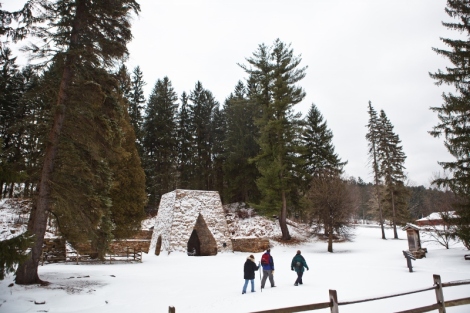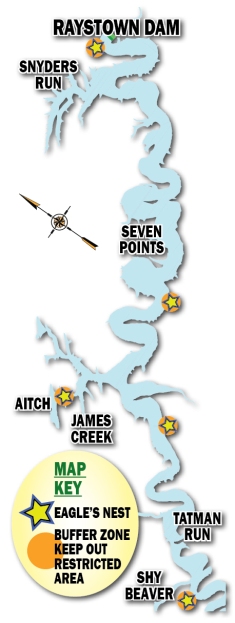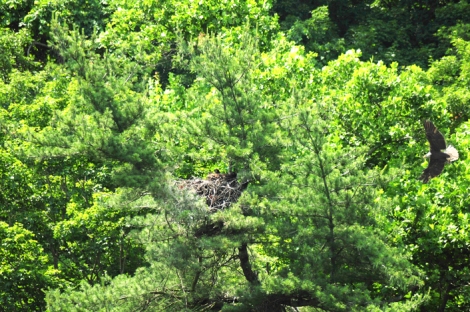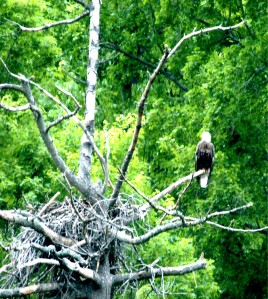Publisher’s Note: The following article appeared in the 2005 Raystown Lake Region/Huntingdon County Visitors Guide. Some links that are no longer active have been removed from its original form. Lake Perez that is mentioned in the article has since been drained, although the Shaver’s Creek Environmental Center and Stone Valley Recreation Area that were once on its shores, are still going strong!
by Chet Clark, AmeriCorps Member, Pennsylvania Mountain Service Corps
Information provided by:
Robert Criswell, PA Game Commission; Chuck Yohn, Juniata College; Jeff Krause, U.S. Army Corps of Engineers; Dave Kyler, Juniata Valley Audubon Society member
Whether it’s a trip to a known birding hotspot or an afternoon watching out the window at home, bird watching as a hobby is on the rise. In fact, in a recent survey, bird watching was at the top of the list for fastest growing activities in the country with an increase in participation of 232 percent since 1983. This increase in popularity is evident in many ways; for example, more than 500,000 copies of The Sibley Guide to Birds have been printed since its release in October 2000, making it the fastest selling bird book ever. Birding festivals are on the increase around the nation as well. In the early 1990’s only a dozen or so existed in the U.S., now about 200 take place annually.
The number of birding trails also is increasing. One unique birding trail was developed in Texas, and over half the states in the nation have followed its lead, including Pennsylvania. These driving trails incorporate stops along the open road at sites chosen for their great birding opportunities. One such trail has been developed in the Susquehanna watershed, which includes the Juniata watershed. The trail stretches across 27 counties (including Huntingdon County) and features 200+ bird and wildlife sites, trails, and scenic drives. Along with the development of this trail, a guide, titled Susquehanna River Birding and Wildlife Trail (available at the Raystown Lake Visitor Center), was created identifying the individual sites. With this guide bird watchers have directions to the best spots to enjoy the many beautiful species of avifauna found in the Raystown Lake Region. Over 25 sites lie within the Juniata River watershed and adjacent areas of the region.
A good place to start your search for our feathered friends is at one of the Important Bird Areas (IBA). These areas were designated by Audubon as such for their abundance and/or diversity of avifauna. One such spot is the Frankstown Branch of the Juniata River, situated in northern Huntingdon County, just off Water Street. “Lower Trail,” part of the Rails-to-Trails system which runs for 16 miles along the river, takes you into some excellent ridge and valley riparian forest habitat. This site is one of Pennsylvania’s most important Cerulean Warbler breeding areas. There are an estimated 50-60 breeding pairs of this illusive warbler along the trail. The Cerulean Warbler is a small bluish-colored (black streaks in the blue above with a white underside) warbler, with a habit of remaining in the high, dense tree canopies. Despite the difficulty of sighting them, their song (rapid buzzes followed by a longer drawn out buzz, zray, zray, zray, zreeeee) can usually be heard throughout the day. Excellent concentrations of other breeding riparian species also are found here. Neotropical migrants (such as the Northern Parula with its bold yellow chin and yellow and chestnut breast with a slate-colored body) are typically much higher in number in this area during the early portion of the spring migration (late April-early May), due to early leaf-out along the river.
Another IBA is Canoe Creek State Park. This area hosts an incredible array of birdlife due to its exceptionally diverse habitat. There are 220 species that occur, with 110 breeding at the site. The habitat types include: large tracts of unfragmented forest (that attract forest-interior neotropical migrants); forested wetlands with many small beaver ponds; laurel thickets; riparian forest; unspoiled emergent and shrub wetlands; native grassland and old-field habitat; and a 160-acre lake. The lake attracts migrating waterfowl in the spring. In the forest interior look for the brilliantly colored Scarlet Tanager. The male Tanager is a beautiful, rich scarlet-colored bird with black wings and tail. The female of the species is an olive shade with gray wings.
The Stone Valley Recreational Area is located across the 70-acre Lake Perez from Shaver’s Creek Environmental Center. Both areas present opportunities to view spring and fall waterfowl and passerine migration species. The tall white pines of the Stone Valley Recreation Area attract Pine Warblers in the spring and summer. At the Shaver’s Creek Environmental Center, visitors find plenty of bird watching opportunities as well as many public programs to take part in. The environmental center also allows for a close up look at many raptor species living there due to injuries too serious to allow for their release. Hiking trails abound and meander through habitats such as hemlock riparian areas, hardwood forest, and open meadows.
The Raystown Lake area also offers some unique birding opportunities. Two active eagle nests provide sighting opportunities all around the lake, with the best spot appearing to be just downstream of the Raystown Dam. This area is fairly reliable for catching a glimpse of the magnificent birds, as they are usually found perched across the river. The Fouses Crossing wetland site has access restrictions for waterfowl propagation between March 15 and August 15 but provides some unique spring and summer birding opportunities. Newly created wetlands along agricultural and moist soil habitat provide great spots to view wading birds such as Herons and Egrets, along with various waterfowl in the spring. The lake also provides winter and early spring viewing opportunities for a variety of waterfowl that utilize the lake as a resting spot during migration. This site is a waterfowl enthusiast’s dream with many species present at one time or another. Common species such as Ring-necked Ducks and Common Mergansers to the not-so-common Black Scoter and Ring-necked Grebe can be seen. One good vantage point is a large cove just south of the Seven Points Recreation Area, that can be accessed from various campground roads. Additionally, the warmer discharge waters of the dam and the dense riparian cover of the Raystown Branch of the Juniata River make the four-mile stretch between the dam and the Point Access a great area for winter bird viewing. Recent hacking programs to reintroduce Osprey at Raystown make them a common, late summer find in the James Creek area of the lake. The many trails at Raystown Lake also provide great opportunities for viewing breeding birds in a variety of habitats. Maps of the trails are available at the Raystown Lake Visitors Center.
If the raptor is your bird of choice, then the Jo Hays Vista is the site for you. This IBA is located over 2,000 feet above sea level atop the Tussey Mountain Ridge. The hawkwatch is known for its high numbers of spring migrating Golden Eagles (more are seen at this site than any other east of the Rocky Mountains), which peaks in the first three weeks of March. Counts of up to 150 annually have been recorded. Along with Golden Eagles, spring counts of up to 6,500 from 15 other species of diurnal raptors have been recorded at the site. Good numbers also can be seen during fall migration. The surrounding area provides good habitat for many breeding birds. Due to the lack of fragmentation throughout the ridge, many forest-interior species are found here. Some representatives include the Yellow-billed Cuckoo, several warblers, and the Scarlet Tanager.
These are just a few of the birding opportunities in Raystown Lake Region. Explore www.pabirdingtrails.org for more information on these and other birding sites in the area. To learn more about birding, contact the local Juniata Valley Audubon Society Chapter. Other interesting information can be obtained by checking out the following websites:
http://www.scbirdcl.org/
http://www.shaverscreek.org
http://www.birding.com/wheretobird/pennsylvania.asp
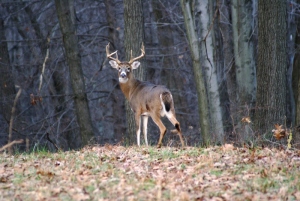 Some of the unique offerings at Raystown include a world class two story fishery that provides common warm water fish such as black bass and walleye while also offering trophy size striped bass and lake trout. Hundreds of annual fishing tournaments and the PA state record striped bass are testaments to the great fishery created by clean water.
Some of the unique offerings at Raystown include a world class two story fishery that provides common warm water fish such as black bass and walleye while also offering trophy size striped bass and lake trout. Hundreds of annual fishing tournaments and the PA state record striped bass are testaments to the great fishery created by clean water.
